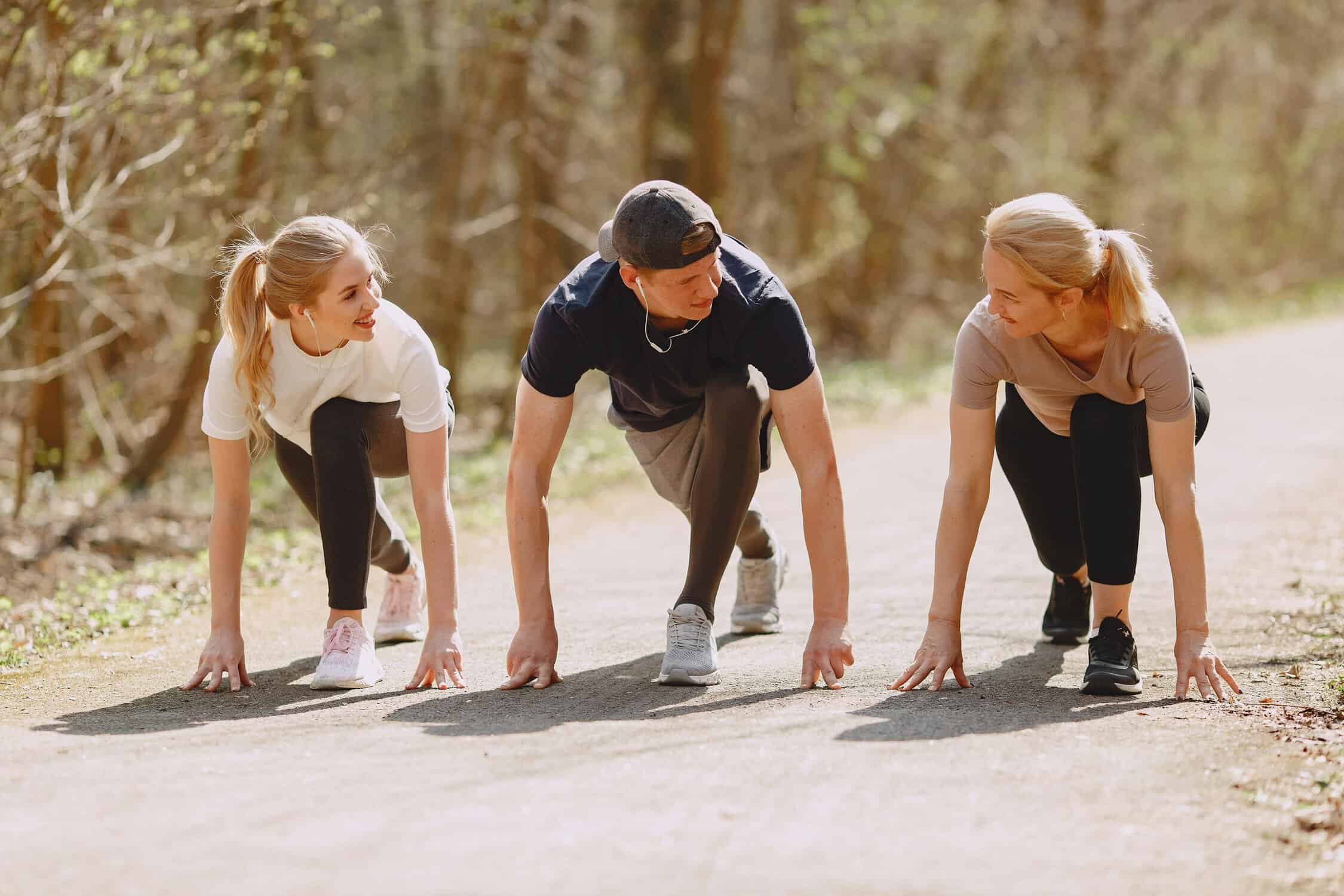Once you’re comfortable with maintaining your running regimen, you’ll start searching for answers on how to run faster and longer. Competing in a 5K is a great goal for a beginner runner. But the more you run, the more comfortable you’ll become with running faster or further. Like most running goals, running faster and further requires slow, methodical day-to-day efforts. Here’s a guide to get you started on improving your speed and endurance.
Who Can Benefit From Increasing Running Speeds and Duration?
Everyone can benefit from improving their running speed and duration. An improved running speed is not about running a faster 100-meter dash (although that may happen), it’s more important to reduce your average minute per mile. The more frequently you run and the more amount of time you spend running will build your body’s endurance. For example, if you run 4 or 5 miles on a long run, 2- to 3-mile runs will feel easy in comparison.
The same principle is true when running faster. If most of your training runs are at 5 miles-per-hour (12 minutes per mile), speedwork that pushes your mile time to 10 minutes per mile will make your training pace runs at 12 minutes per mile feel much easier.
Improving speed and endurance should only be done once you’ve established a strong running base. Before speed and distance, you should::
- Improve your running form
- Build leg and cardiovascular strength over shorter distances
- Create a stretching routine to prevent injury
- Establish and maintain a weekly running routine
After several months of running, you can begin to work on increasing speed and endurance.
For speed and endurance workouts, Runna Head Coach Ben Parker recommends using Runna’s Advanced 13.1 Training Plans, which Half Marathon Guide readers can download free here.
How to Optimize Your Runs For Running Faster
No immediate, definable method dominates for going faster or farther. All improvements in speed or distance require intentional training protocols like those listed below
Plyometric Training
Bodyweight strength training helps to build lean muscle mass that will support stability without adding the weight of heavier muscle mass.
Plyometric training includes three rapid phases of movement — eccentric pre-stretch, amortization and concentric shortening. These fast, powerful movements call on energy for fast muscle contraction to fuel explosive power, the same muscle patterns when running quickly.
Some examples of explosive, bodyweight plyometric exercises include:
- Box jumping
- Burpees
- Lateral bounds
- Squat jumping
- Reverse lunge knee-ups
- Tuck jumping
These exercises are meant to sustain a high heart rate, training your body to build strength and stamina during times of more vigorous exercise.
Most of these exercises do not require equipment and can be done at home.
Cross Training
You can’t run every day and give your body the time it needs to recover from long training runs or speedwork training. Taking days off from running to cross-train can improve both your speed and endurance.
Other activities that are complementary and not cannibalizing to runners include:
- Spinning or cycling
- Crossfit
- Swimming
- Elliptical
- Walking
- Yoga
- Strength training
- Golf
Cross-training may help improve your cardiovascular endurance, boost your range of motion and flexibility, and allow your legs to recover from running stress.
Run-Walk Method
The run-walk method is not just for beginner runners. Firstly, integrating run-walk workouts into your routines can help you get faster because it will allow you to run with quicker, shorter sprints over the course of a longer run. Secondly, increasing how many miles you run will benefit from covering a few miles at a walking pace.
With the run-walk method, you’re able to alternate mile by mile 10-20% quicker than your standard pace with your walking pace. So, if you normally run a 12-minute-mile pace, consider an 11- or 10-minute-mile pace followed by two minutes of walking. Whatever you choose for your faster run pace, you want to be able to hold for 10 repetitions of the exercise to run these short sprints for 30 minutes.
“The method was pioneered by Olympian Jeff Galloway, but has become common in all training plans today” says Runna Head Coach Ben Parks.
Hill Training
Running uphill puts higher demand on runners because there’s the additional force of gravity acting against your run. In turn, runners develop stronger quad and glutes from hill training, which converts to quicker running speeds.
Hill training can be done on any incline, the steeper the better for muscle activation. The workout involves a quick sprint up the hill, with a jog or walk back down. The hill should be no less than 100 meters long.
Start training with five hill repeats and add an additional repeat weekly. Hill workouts shouldn’t last longer than 30 minutes per session.
Work on Your Breathing Techniques
One of the biggest challenges with speedwork training is the intense cardiovascular demand — aka, you’ll find yourself out of breath quickly. Working on breathing techniques will allow you to feel more comfortable with each session.
Avoid shallow breathing from your chest. Coaches and physicians recommend belly breathing instead, which helps transport more oxygen to your muscles.
It might seem silly at first, but take a few minutes each day to practice diaphragmatic breathing. Place one hand on your upper chest and the other on your belly. Breathe through your nose, allowing the air to fill your belly. The hand you placed on your chest should not move but the one on your belly should rise and fall with each breath. As you exhale, tighten your abs and allow them to move inward as your hand returns to its original location. Repeat for several minutes to get used to this deeper breathing method to implement it during running.
Listen to Music While Running
Music can act both as a distraction from the monotony of running as well as stimulate the production of dopamine — which produces the endorphins of a runner’s high. Some runners find that songs they’ve heard hundreds of times become monotonous, so they want to be entertained another way. If you’re one of those runners, an engaging podcast or audiobook might be better for keeping your mind off how much longer, farther or faster you have to run. The goal here is to keep yourself distracted so you can accomplish your goals for the workout.
Adequate Recovery
Overtraining is common among runners. Allow time for adequate recovery between runs and be disciplined to stretch all your lower body muscles to prepare for your next training session.
After running, complete a stretching routine to prevent tight muscles or the build-up of lactic acid, which may prevent you from running. A common location for tight muscles after an intense workout is your hips, and when your hips are tight, it will affect your stride length. To get faster, incorporate hip stretches for mobility to improve your stride length for optimal results.
Other crucial elements of recovery are hydration, nutrition and sleep. Without adequate nutrients and rest, your body won’t be able to perform at its peak. Dehydration will cause you to feel sluggish.
Optimizing all elements of your health and well-being is crucial to increasing mileage and speed safely.
Focus on Overall Well-being for Speed and Endurance
Ultimately, if you’re wondering how to run faster and longer, you need to look at your overall well-being. Training more or longer isn’t always the answer. You might need to fix your habits first, such as ensuring you get no less than 7 hours of sleep per night and that you’re fueling your body with healthy food and adequate hydration. Then you’ll be ready to take on strength training, cross-training and various types of running in your pursuit of speed and endurance.
Frequently Asked Questions for the Head Coach at Runna
Should I breathe through my nose when running?
Breathing in through your nose and out through your mouth can bring more oxygen into your body to power your muscles and keep your mind clear. It might take some getting used to, but it can help you avoid cramps and power you to faster, longer runs.
Can cross-training make you faster?
Cross-training helps runners build strength while working on endurance and cardiovascular health without the risk of injury associated with running too often or too hard.
Does plyometrics increase stamina?
Plyometrics can increase your strength and stamina to improve other activities, such as running.
Runna is Half Marathon Guide’s official training app partner. All Half Marathon Guide readers are eligible for a two week free trial






